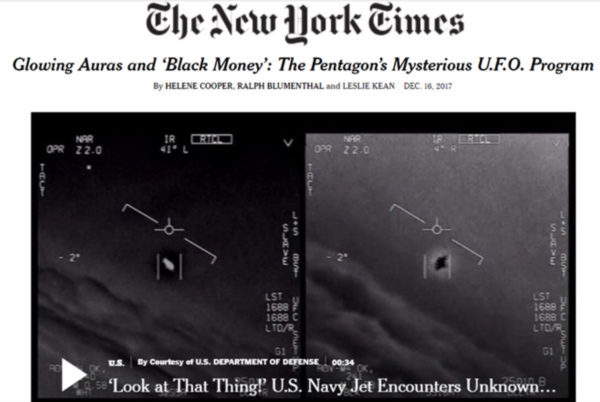In the current wave of UFO disclosures, the press (in particular, the New York Times) has decided to use Luis Elizondo, a career intelligence case officer, as its main source.
This choice reveals a time-honored strategy of elite news operations: cherry-pick who is reliable and who isn’t.
Of course, the press presents its case as flowing FROM the source. But that’s not true, because reporters and editors could have used other “reliable sources” to tell a different, or even contradictory, story.
Everything depends on who, at the moment, is pumped up and ushered on to center stage, and tagged as “reliable.”
I’m not saying Mr. Elizondo is telling lies from wall to wall. But, for example, where was the Times when reports began to emerge of UFOs appearing at a missile base in Montana (1967) and shutting down launch-capability? There were a number of professional military observers at the time. They could have been deemed “reliable sources,” but they weren’t. For decades, this event has been suppressed or downplayed by the mainstream press.
“Well, we did look into it, but we concluded there just wasn’t enough there. We didn’t go with the piece because the confirmation was thin.” That’s a frequent excuse. Often, it doesn’t hold water. It reflects an arbitrary decision to ignore a valid account.
This is how the game is played.
“Reliable source” can be managed, on a case by case basis.
“Let’s see. We can imply the steep rise in autism is the result of more careful monitoring of cases, or a genetic problem, or the rapid expansion of the CDC vaccination schedule. Let’s do a piece on genetics. Who can we tap for comments? Round up the usual list of expert sources and get quotes. ‘New research suggests a stronger link to genes than previously supposed.’ That’ll work…”
When I was writing my first book, AIDS Inc.: Scandal of the Century, in 1987, I decided to look into the widely promoted notion that HIV had spread to humans, in Africa, through contact with green monkeys. When the US press wants to promote a “new disease,” they inevitably go to far-off places around the globe for their “origin story.” The last time I looked, no new epidemic has ever begun in Brooklyn. I called a prominent AIDS researcher at Harvard. Without pause, he told me the green monkey theory had no evidence to support it. Well, obviously, the press hadn’t used him as a “reliable source.” They might use him to comment on other matters, but not this one—because “green monkey” was the preferred scenario for the moment.
On the UFO front, the Times could have jumped with both feet into Steven Greer’s Disclosure Project years ago (Twitter). Greer had scores of military and intelligence officers who were testifying to all sorts of UFO contact. But back then, the story was verboten. So the sources were ignored.
Sometimes, the graduation from nonsense-story to breaking news isn’t the decision of a major press outlet. The newspaper or broadcast network takes its cue from a “higher authority.” The CIA or the Pentagon, for example. Or from an anonymous heavy hitter who will never be revealed. Depending on the topic of the story, the heavy hitter could exist within the core of the Bilderberg Group, the Trilateral Commission, the Vatican, the upper reaches of the “banking community” (a Rothschild front man), etc.
This is the “green light” phenomenon. What was once a studiously ignored piece suddenly turns into an imperative to publish. The chosen news outlets jump into action.
The green light can also click through indirect means. Consider the name, Jim Semivan. He is on Tom DeLonge’s team at the newly formed To the Stars Academy, the group which includes Mr. Elizondo, mentioned above. Here is a thumbnail bio of Mr. Semivan from Simon & Schuster publishers: “Jim retired in 2007 after a 25-year career in the Central Intelligence Agency’s National Clandestine Service. At the time of his retirement he was a member of the CIA’s Senior Intelligence Service. Jim served multiple overseas and domestic tours along with senior management positions in CIA headquarters. He is the recipient of the Agency’s Career Intelligence Medal.”
Semivan’s emergence in UFO disclosure activities would alert the New York Times that it should pay attention to any information coming out of To the Stars Academy. Semivan is more than a witness or a researcher. He’s a high-level man connected to the intelligence community. If he backs up a story, it’s “official.”
I’ll give you a name: Richard Dolan. Dolan is the author of books on UFOs, and he is a publisher in the same field. A highly intelligent observer, when he makes inferences from data he explains his reasons. He possesses a formidable knowledge of UFO incidents over the course of decades. Major media outlets could go to him as a direct source for articles, or as a guide who could point them to credible stories. But that doesn’t happen.
Why? Because Mr. Dolan could unleash “too much information.” He could open up too many cans of worms. And he doesn’t have an official position in government or corporate circles.
He is reliable, but not in the media sense of the word. He could give, say, the reporters at the New York Times far more help than their editors could—but that doesn’t matter.
What matters to the Times and other mainstream outlets is the agenda of the moment. And who will bolster that agenda.
Why isn’t long-time UFO researcher Grant Cameron writing op-ed pieces for the Times? He has a very interesting take on how various UFO spokespeople have been used by the military-intelligence complex. Alas, Cameron makes too much sense. He goes too deep. So instead, a Times reporter writes a human-interest story about his father. The father was a veteran UFO watcher, who sadly died before the US government “admitted UFOs exist,” a couple of weeks ago.
At any time over the past 40 years, the Times could have assigned a couple of reporters the job of assembling a history of bullet-proof UFO-encounter stories. For a major article. An article that would have settled the issue once and for all: UFOs, whatever they are, exist, and they exhibit extraordinary capabilities.
But “it wasn’t time.”
Now, it is.
The green light is on. But it is only glowing for certain people, and for chosen news companies.
The Reliable Ones.
Therefore, when the Times, or a comparable media operation, discloses UFO revelations, the stories—accurate or not—reflect a purpose that is hidden.
That purpose is never the unvarnished and complete truth.
Over the past 35 years, working as a reporter, I’ve spoken off-the-record with a number of mainstream journalists. They readily admit to making “partial disclosures,” otherwise known as limited hangouts. They explain this as “sticking to the facts at hand.” But that’s not true. They also admit their editors keep them from digging deeper on a story.
Digging deeper would, of course, expose unpleasant scandals the public shouldn’t be aware of. And in the process, people who are deemed unreliable sources would be vindicated. If THAT happened, the whole proprietary media egg would crack.
The public would understand, beyond the shadow of a doubt, that big media cherry-pick their sources, and mainstream news is a stage play.
An acid test: If the New York Times gave the first five pages of their paper to a few independent UFO reporters for a week, those reporters could write a slew of hard-hitting factual pieces that would shake the foundations of knowledge about UFOs. Sales of the paper would skyrocket, and names like Luis Elizondo and Jim Semivan would fade far into the background. The public would realize that verified sightings of UFOs go back at least 50 years. And that would be just the beginning of actual Disclosure.
“Reliable source” is a pliable term. In the media landscape, it implies that editors and publishers are in charge of defining it, at any given moment, to suit their agenda.
If tomorrow, for example, the Times decided that the famous Lockheed Skunkworks, located in the desert (Palmdale, California), was their primary target, as in—what have they been building out there for years?—a whole new raft of reliable sources would come into play overnight. Setting their hounds loose, with no restrictive deadline, the Times might experience what it’s like to operate as an actual news outlet.
They would eventually penetrate many cover stories. What would they discover?
The former director of the elite Skunkworks, Ben Rich, before his death, is reported to have said (UCLA School of Engineering speech, March 23, 1993):
“We now know how to travel to the stars…There are many in the intelligence community who would like to see this stay in the black and not see the light of day.”
Now there’s a potential source—an insider’s insider. Did Ben Rich say that? Is it true? If it’s true, how did Lockheed develop/obtain the technology?
Why not pursue that lead and run it down?
“Well, we don’t like to rely on dead sources, especially when they make bizarre claims.”
Who says the claim is bizarre? The CIA? The Pentagon? Lockheed?
They’re automatically listed as reliable?
Is “hard to believe, hard to fathom” an unimpeachable standard for barring investigations without further thought?
Wasn’t, for instance, the whole CIA MKULTRA mind control program bizarre and hard to believe, before it was exposed?
Thousands of events and programs are impossible, before they turn out to have happened.
The idea that the New York Times, the number one media outlet in the world, isn’t devoted to the truth—that idea would be very hard for many people to believe; until it’s shown to be factual.
“Hi, I’m major media. I depend on reliable sources. I decide who is reliable and who isn’t, on any given day of the week. I use these sources to construct and shape Reality for the masses. That’s my job. I spend gargantuan amounts of money in this effort. After all, inventing Reality is an awesome mandate. You can’t fool around with that. You must be convincing. If I tried and failed, the consequences would be devastating. A few billion people would see holes in Reality Itself. This is not permitted to happen.”
Ah, but it is happening. Deepest apologies.
The Reality Manufacturing Company is at DEFCON 1, red lights are blinking, and systems are going down.
Source: www.activistpost.com




